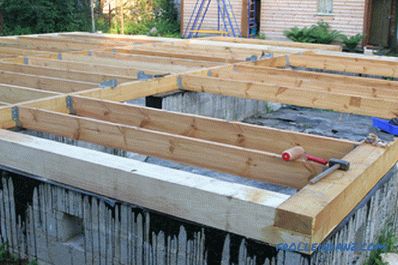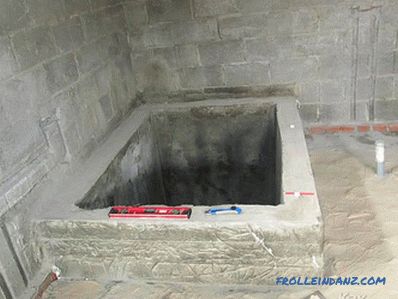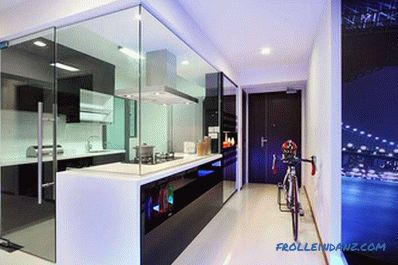Today laminate is the most common flooring. Ease of installation, reasonable price, aesthetics of the laminate made this type of finishing material one of the most popular. Laying laminate without thresholds is another new trend in flooring. With this method of laying the room looks more spacious and monolithic, eliminating the risk of tripping on the threshold.
Disadvantages of non-threshold styling
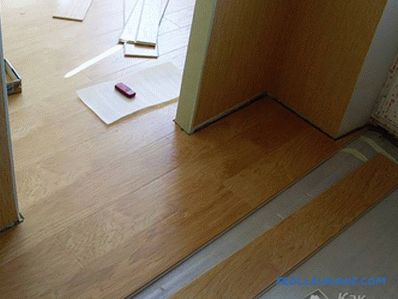 A laminate stacked in a non-threshold manner can swell
A laminate stacked in a non-threshold manner can swell
- Without thresholds it is possible to lay a room with an area of no more than 50 m 2 , length from 8 to 10 m with a laminate board. In a larger room, the laminate flooring can swell, especially in places of doorways.
- The way of laying without thresholds will require certain skills, abilities and takes more time.
- If you need to replace just one laminate panel, you will have to disassemble the entire floor covering in order to get to one damaged board.
The larger the area of seamless laminate laying, the greater the likelihood of deformation of the floor and its swelling.
Despite the warnings, thousands of ordinary people are willing to take the risk and make a seamless laminate flooring in their apartment to achieve visual space.
Before proceeding to the threshold-free installation of laminate panels with your own hands, it is advisable to become familiar with the theoretical nuances of seamless installation, as well as to determine the method of fastening the panels.
Methods of fastening laminate panels
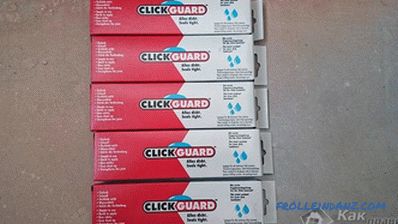 Glue for laminate
Glue for laminate
Fastening on glue . This type of panel connection involves gluing laminate boards together.
Advantages:
- this method is ideal for rooms that are heavily polluted and with high humidity;
- the joints are reliably sealed, they do not enter dirt and trash.
Disadvantages:
- Errors are not allowed, since all flooring will have to be removed.
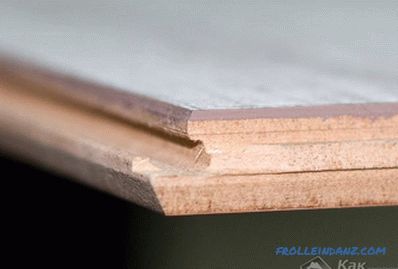 Castle method of fastening
Castle method of fastening
Castle method of fastening . It assumes the presence of panels with special locks-latches.
Advantages:
- locking fasteners allow you to more accurately adjust the boards;
- it is possible to lay laminate panels in different directions, which is very convenient when installation of flooring;
- possibility of dismantling a small area of the coating, if you need to replace several boards;
- simplicity and ease of installation;
- saving time.
Disadvantages:
- high cost of laminate panels with a lock profile.
A necessary tool for seamless laying of laminate
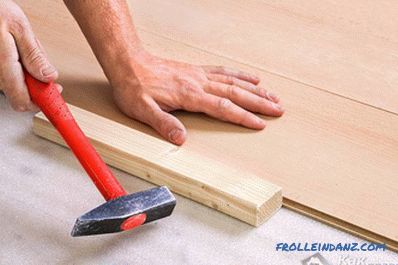 Tools for laying
Tools for laying
Before laying laminate panels, you need to prepare a tool:
- electric jigsaw, if you don’t have one, you can use a hacksaw, however, you can not achieve high accuracy;
- tape measure;
- laser level;
- punch;
- pencil;
- glue (if an adhesive mounting method was chosen);
- a square;
- miter;
- restrictive wedges;
- rubber mallet;
- lining bar.
This set of tools and accessories is quite enough to carry out non-threshold laying of the laminate.
Choosing a laminate class

The choice of laminate panels will depend on the degree of load on the flooring. In order to figure out which class of laminate should be used as a floor covering, you need to familiarize yourself with the classification of the room (table 1).
Table 1 - Choosing a class of laminate depending on the load on the flooring
| Type of load on the floor | Class of laminated panels |
| Residential premises: a) low load | 21 |
| b) average load | 22 |
| c) high load | 23 |
| Public rooms : a) low load | 31 |
| b) average load | 32 |
| c) high load | 33 |
| g) very high load | 34 |
| P industrial premises: a) low load | 41 |
| b) average load | 42 |
| c) high load | 43 |
As can be seen from the table, the greater the load on the floor, the higher class of laminate must be used. The choice of class of floor material is determined by the total degree of load throughout the residential area.For non-threshold laminated board installation, experienced specialists advise to choose panels of class 33 or 34. This class of panels has a high degree of wear resistance. With the right installation technology, the floor material will not bulge, but will last for more than 20 years without the need for a complete replacement.
Subtleties of non-threshold styling

- The room in which the laminate is laid must have normal humidity. Otherwise, laminate panels may swell and deform.
- The base on which the laminate is laid must be perfectly flat. Surface height differences should not exceed 3–5 mm.
- If the laminate panels are laid on a wooden base, then fragments of the floor that have deformation or rotted areas should be replaced.
- Cork and polyethylene can be used as a substrate for a laminate flooring, as well as cardboard sheets that are joined together with adhesive tape. It is not recommended to use carpet because of its high softness.
- Since the laminate belongs to "floating" floor coverings, it is necessary to leave gaps along the walls when laying it. The width of the gaps is 1 cm. For uniform installation and accuracy of the location of the panels, it is necessary to install special plugs between the laminate and the wall, which are removed after work is completed.
Stages of non-threshold laminate flooring
The process of laminate flooring itself is simple if you know the technology and take into account the features of the seamless coating. The algorithm of seamless styling is presented below.
Preparatory stage
 Laminate screed
Laminate screed
Dismantling the old coating and leveling the rough floor. If the surface of the base has slight drops, then it is enough just to remove the roughness and level the floor by stripping. If the base is badly damaged, then a concrete screed is required. The concrete screed must dry for three months. The surface of the base must be flat, clean and dry.
Installation of the insulation layer
 Substrate
Substrate
- Insulation layer (mineral cotton wool) is immediately placed over the entire area of the room;
- The apartment uses only a substrate (cardboard, polyethylene or cork), which prolongs the life of the laminate and serves as a shock absorber.
Laying laminate panels
- The installation of the covering should be started from the window, carefully connecting the laminate boards with the help of locks.
- When laying, it is necessary to pay attention to the first three rows, as they will be fundamental in the further installation of the panels.
- Be sure to leave a gap between the wall and the panels (approximately 1 cm). Then the gaps are closed with baseboards that are attached to the wall.
- Laminate should be laid under the door frame so that it “breathes”. To do this, at the bottom of the door frame should make a small cut. Slats in the combined rooms should be laid in one direction. Interior doors during installation, it is desirable to remove.
 Laying in the doorway
Laying in the doorway
To make the room appear visually spacious and monolithic, laying laminate panels need to be done only in one direction.
It is quite easy to make the floor beautiful, durable and reliable, with knowledge and respect for all the features and nuances of seamless laminate installation. Watching a video will help avoid mistakes and undesirable consequences.
Video
Features of laying laminate in the doorway with threshold-free installation:
